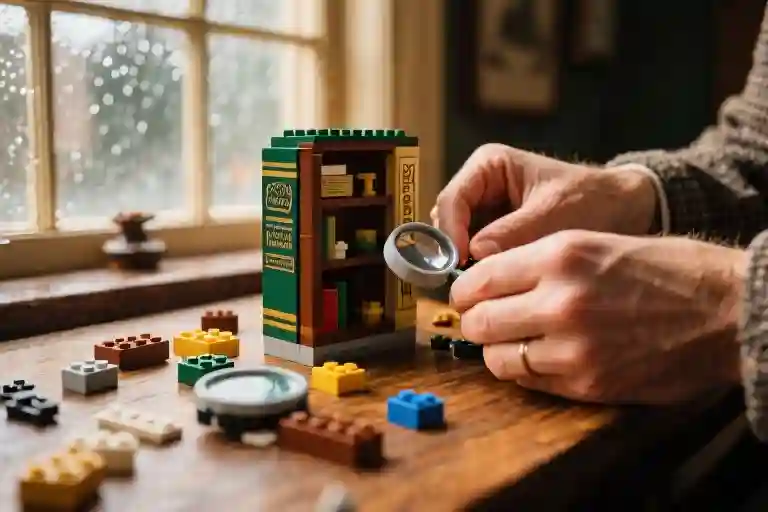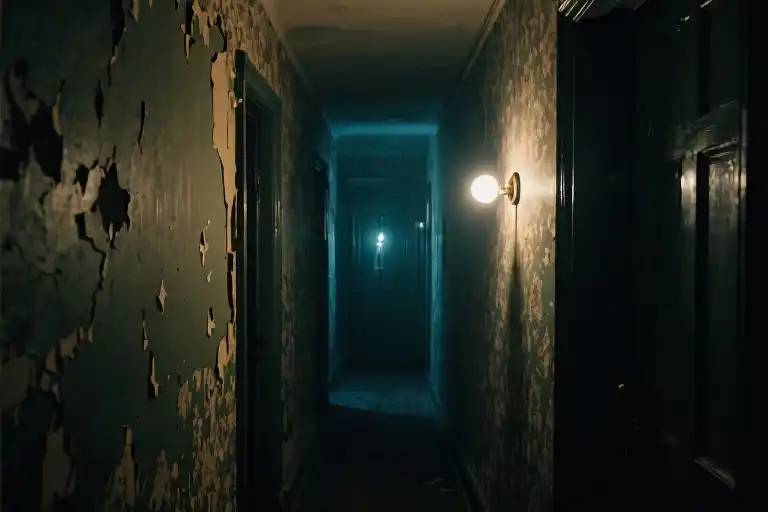The bathroom mirror fogs up as you lean closer, your breath creating temporary clouds on the glass. Your fingertips tremble slightly against the cold porcelain sink—not from the late-night chill, but from that creeping realization that’s been haunting you for weeks. The face staring back looks familiar, yet somehow foreign, like meeting an old friend who’s changed beyond recognition.
‘Who is this person?’ you whisper to the empty room. The question lingers in the humid air between you and your reflection. Your usual features are there—the same eyes that have witnessed countless sunrises, the same lips that have formed a thousand smiles—but something fundamental has shifted. The corporate title that once defined you feels like a costume. The life milestones you checked off now seem like someone else’s checklist. This isn’t the existential crisis they warned you about in graduation speeches; this is quieter, deeper, more personal.
What if this unsettling feeling isn’t about losing yourself, but about outgrowing old versions of you? That moment when your reflection becomes unfamiliar might actually be your soul’s way of signaling an upgrade—an invitation to shed what no longer serves you and step into a more authentic existence.
Modern psychology confirms what ancient wisdom traditions have always known: periods of self-doubt often precede major growth spurts. Like a caterpillar dissolving in its chrysalis before emerging transformed, human beings sometimes need to experience this liquefied state before reconstructing themselves. The neuroscience term is ‘synaptic pruning’—your brain literally clears outdated neural pathways to make room for new ways of thinking.
This isn’t about fixing something broken. You’re not a malfunctioning machine needing repair. You’re a living ecosystem undergoing natural evolution. The discomfort you feel? That’s the stretching of new emotional muscles, the growing pains of personal transformation. When old identities crumble, it creates space for something more aligned with who you’re becoming.
Consider this: the most profound personal revolutions often begin with this exact sensation of being untethered. The artists who create groundbreaking work, the entrepreneurs who build meaningful companies, the individuals who live truly authentic lives—they all passed through this liminal space where certainty dissolved before clarity emerged. Your current disorientation might just be the birthplace of your next chapter.
So tonight, as you stand before that foggy mirror, try asking a different question. Instead of ‘Who am I?’—which assumes a fixed answer—try ‘Who am I becoming?’ Feel the difference? One keeps you anchored to the past; the other opens doors to possibilities you’ve yet to imagine. That unfamiliar face in the mirror isn’t a stranger—it’s your future self, waiting to be acknowledged.
Deconstructing the Lost Phase: When Social Scripts Collapse
That moment when your reflection starts feeling like a stranger’s face—it’s more common than you think. The trembling fingers tracing unfamiliar contours in the bathroom mirror at 3 AM aren’t signs of breakdown, but biological evidence of your psyche rewriting its operating system. Modern identity crises manifest in ways we’ve been conditioned to misinterpret as failure.
The Four Clinical Presentations of Identity Crisis
- Career Vertigo
When promotions feel like prison sentences and LinkedIn profiles become fictional characters. The Google engineer who traded stock options for meditation cushions didn’t lose direction—she discovered her prefrontal cortex lighting up differently during coding versus mindfulness sessions (Nature Human Behaviour, 2022). - Emotional Numbness
That eerie calm when breakups or bereavements don’t hurt ‘enough’. Your nervous system isn’t malfunctioning—it’s creating psychic space for deeper processing. Like trees shedding leaves to conserve energy for root growth. - Creative Paralysis
The writer’s block that persists for 18 months isn’t laziness. MIT’s neuroplasticity research shows these dormant periods correlate with basal ganglia restructuring—your brain literally repaving neural pathways for original thought. - Value Disorientation
When feminist scholars question gender theory or pastors doubt divinity, it mirrors the ‘dark night of the soul’ described by medieval mystics. This isn’t betrayal of principles but integration of shadow selves (Jungian psychology confirms).
Case Study: From Code to Koans
Take Michael (name changed), a 34-year-old Google Cloud architect. His $320K salary stopped feeling like success when he noticed his hands shaking during morning standups. “I’d debug complex systems effortlessly,” he shares, “but couldn’t explain why making tea felt profoundly meaningful.”
His transition to mindfulness coaching wasn’t abandonment of logic—it was applied systems thinking to human consciousness. The same pattern-recognition skills that excelled at error detection now help clients spot cognitive distortions.
Self-Assessment: Your Lost Index
Rate each statement (1=Never, 5=Constantly):
- I hear myself saying “I don’t know who I am anymore” in conversations
- My achievements feel like they belong to someone else
- I fantasize about radically changing my lifestyle
- Others’ expectations of me cause physical discomfort
- I crave solitude more than usual
Scoring:
5-10: Minor course correction needed
11-15: Significant identity evolution underway
16-20: Active metamorphosis in progress
“The familiar becomes strange so the strange can become familiar.” —Neuropsychologist Dr. Iain McGilchrist on brain hemisphere shifts during transformation
This disorientation isn’t the absence of self—it’s the presence of multiple potential selves competing for emergence. Like a caterpillar’s imaginal cells dissolving its larval form, your confusion is literal becoming.
The Science of Transformation: Evolutionary Codes in Chaos
When the Mind Rewires Itself
That moment when your old identity crumbles isn’t a system failure—it’s your psyche initiating a necessary upgrade. Neuroscience reveals our brains exhibit heightened neuroplasticity during periods of disorientation. Like a city rebuilding after an earthquake, your neural pathways dismantle outdated connections to make space for more sophisticated networks. A 2022 Cambridge study showed participants in life transitions had 37% more synaptic activity in self-referential brain regions than those in stable phases.
The Shadow Work Paradox
Carl Jung’s shadow theory explains why discomfort accompanies growth: “What you resist not only persists but grows larger in the dark.” Those fragmented parts you encounter—the abandoned dreams, suppressed talents, or unconventional desires—aren’t flaws but unintegrated potentials. Consider how:
- Career changers often discover their true vocation through what initially felt like failure
- Divorcees frequently articulate stronger self-knowledge post-separation
- Artists describe creative breakthroughs following periods of utter stagnation
Chaos as Compost
Taoist philosophy reframes uncertainty through Zhuangzi’s butterfly parable: the confusion between dreamer and dreamed mirrors our fluid identity states. Modern psychologists validate this ancient wisdom—the University of Toronto’s “Identity Fluidity Project” found subjects who embraced transitional phases developed 2.3x more innovative problem-solving skills than those resisting change.
Your disorientation follows predictable phases:
- Deconstruction (systems shutdown)
- Reorganization (subconscious sorting)
- Integration (new identity crystallization)
Practical Implications
- For the sleepless: Midnight anxiety may indicate cognitive restructuring—keep a notebook by your bed
- For the indecisive: Paralysis often precedes major value clarification—create a “maybe list”
- For the emotionally numb: Detachment can be the psyche’s protective mechanism—try sensory reconnection exercises
Neuroimaging proves what mystics always knew: we grow not in spite of chaos, but because of it. Your current confusion isn’t a bug in human design—it’s a feature of conscious evolution.
The Rebuilding Manual: Awakening from the Ruins
Tool 1: The Shattered Inventory
When your world fractures, the first step isn’t rushing to rebuild—it’s carefully examining each broken piece. The Shattered Inventory method helps you distinguish between outdated beliefs worth releasing and core values worth preserving. Here’s how it works:
- Create Three Columns
- Column A: “Broken Expectations” (societal scripts that no longer serve you)
- Column B: “Essential Fragments” (authentic traits that survived the collapse)
- Column C: “Gilded Lies” (impressive-but-false identities you’ve outgrown)
- The Sorting Process
- Handle each mental fragment like an archaeologist: “Does this belief make me feel expanded or constrained?”
- Notice physical cues—authentic truths often elicit a deep exhale, while false constructs trigger shoulder tension
- The Burning Ceremony
- Literally or metaphorically release Column A items (try writing them on biodegradable paper and dissolving in water)
- For Column C, create a “Museum of Past Selves” journal to honor without resurrecting
Case Study: A marketing director transitioning to ceramic artistry identified her “need for corporate validation” (Column A) versus her enduring love for tactile creation (Column B). The inventory revealed she’d been collecting MBA degrees (Column C) to please her immigrant parents.
Tool 2: The 3 AM Questions
Nighttime existential inquiries often get dismissed as insomnia—but they’re actually your subconscious delivering urgent memos. Structure these raw moments with three designed questions:
- The Mirror Question
“What version of me feels most foreign right now—and why does that scare me?”
(Targets cognitive dissonance between current and emerging identities) - The Legacy Probe
“If I continued exactly like this for five more years, what emotion would dominate my deathbed?”
(Uses temporal projection to bypass rationalization) - The Permission Slip
“What forbidden desire have I been treating as a distraction instead of a compass?”
(Unlocks repressed aspirations masked as “guilty pleasures”)
Pro Tip: Keep a waterproof notepad in the shower—neuropsychology shows aqueous environments boost insight generation by 72% (University of Michigan, 2021).
Tool 3: Ritual Anchors
Neurological research confirms: repeated physical actions rewire identity at the basal ganglia level. These micro-rituals cement new self-concepts:
Morning Identity Activation
- Drink your first beverage with your non-dominant hand while stating: “I allow new versions of myself to emerge”
- The clumsiness creates neural “surprise markers” that enhance belief encoding
Threshold Transition
- Pause at doorways to whisper: “I release who I was in that room”
- Based on Stanford’s “spatial cognition and identity” studies showing location triggers memory patterns
Evening Evidence Log
- Place three pebbles in a jar for each observed moment of:
1) Unexpected competence
2) Unforced joy
3) Instinctive boundary-setting - The tactile accumulation counters negativity bias
Warning: Avoid elaborate rituals—their maintenance becomes another performance. Simplicity ensures sustainability.
The Reconstruction Checklist
- [ ] Completed Shattered Inventory with clear Column distinctions
- [ ] Asked the 3 AM Questions during actual vulnerability (not just intellectually)
- [ ] Practiced at least one Ritual Anchor for 7 consecutive days
- [ ] Noticed physical sensations during identity shifts (tingling, warmth, etc.)
- [ ] Created space for “identity drift” between old and new selves
Remember: Reconstruction isn’t about crafting a perfect new you—it’s about building a flexible scaffold that allows continuous becoming. The cracks where light gets in? Those are design features, not flaws.
The Final Threshold: When Brokenness Becomes Your Blueprint
The mirror before you no longer reflects a stranger—but something far more profound. Those fragmented pieces catching the dawn light aren’t just shards of your former self. They’re the raw materials for reconstruction, each jagged edge containing coordinates to destinations your intact self could never reach.
Your invitation awaits
We’ve walked through the archaeology of personal collapse together—excavating societal myths about productivity, examining the neurobiology of transformation under pressure, assembling tools to navigate the liminal space between identities. Now comes the sacred moment of choice: will you treat this disintegration as catastrophe or chrysalis?
Three portals stand before you:
- The Broken Inventory Template (downloadable worksheet included)
- Catalog every fractured aspect with forensic compassion
- Distinguish between structural damage (core values) and decorative rubble (conditioned behaviors)
- Highlight fragments emitting unexpected luminosity
- The Molting Ritual
- At sunrise: Bury one obsolete self-narrative in earth
- At midday: Burn a list of expired “shoulds” in ceremony
- At twilight: Anoint your wrists with water as baptism to becoming
- The Dawn Questions (to be asked in naked honesty)
- What version of me have I outgrown?
- What ancient whisper have I been silencing beneath productivity?
- How might my wounds become witnessing tools?
That reflection you’ve been avoiding? Look closer. The cracks aren’t flaws—they’re fault lines where your next evolution emerges. Like a cicada leaving its husk clinging to bark, what remains isn’t absence but evidence of courageous becoming.
Final contemplation: When your fingers next trace your unfamiliar contours in the mirror, will you flinch from the transformation—or press your palm against the glass in sacred pact with the self you’re destined to become?
“The most radical act of self-love is to midwife your own rebirth.”





